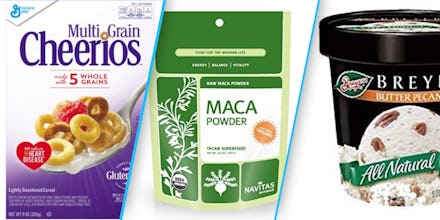7 Times Food Packaging Labels Straight Up Lied to You

Spoiler alert: Food marketers will do just about anything to convince consumers to purchase products. One of the best tricks in the book? Slap some confusing health buzzwords on a package that make even the most caloric, nutrient-void product seem like it's the fountain of youth and healthfulness.
And it works. A 2015 study conducted by Consumer Reports revealed that 62% of shoppers report they buy foods labeled "natural" because a majority of them think this label means more than it does. The term "natural" means next to nothing, yet it helps sell $40 billion worth of food a year in America, according to the Washington Post.
What do "natural" and other food marketing terms really mean? Not much.
Here's how to decode food labels the next time you're at the store.
1. Natural and All-Natural
The word "natural" splashed on the packaging above makes it seem as though the pint of Breyer's ice cream is a healthy treat. In reality, these terms don't mean anything about a product's nutritional content.
The U.S. Food and Drug Administration has no formal definition of "natural" or "all-natural," so these these words may be used to describe a range of products, the Academy of Nutrition and Dietetics reported. A 1993 policy stated that these products cannot contain added color, artificial flavors or synthetic substances.
2. Superfood
Seaweed? Maca powder? Goji berries? There's no end to the number of foods that have been awarded the moniker "superfood" by marketers. But these foods won't magically add years to anyone's life or make someone into an invincible superhero.
"Strictly speaking, all fruits and vegetables are 'superfoods,' because they all provide important vitamins, minerals and phytochemicals that help keep us healthy," nutritionist Fiona Hunter told Reader's Digest. In other words, no pressure to drop cash on the latest "superfood" at Whole Foods.
3. Unprocessed
Ah, yet another word that has no bearing on a product's nutritional value. Processed foods aren't the devil — in fact, "processed" refers to anything you do to food, be it cooking, canning, mashing, grounding or baking, the Washington Post reported. It's basically semantics.
Just how meaningless is the term "unprocessed?" Raw peanuts may be labeled unprocessed while peanut butter made with just peanuts (and nothing else) would have to be labeled "processed." One could even argue that lettuce is a "processed" food, if it has been pre-washed and packaged.
4. Gluten-Free
Marketers continue to slap this term on products that were already gluten-free in the first place. Case in point: The tortilla chips in the photo above. While they're not the worst snack in the world, they aren't as nutrient-dense as a handful of blueberries or some sliced apple topped with peanut butter (a snack that's rich in fiber and healthy fats and is also gluten-free). Other products that are usually gluten-free? Hummus, fruit juices, chocolates, oatmeal, cheeses, yogurts and dried fruit.
Slapping the term "gluten-free" on these foods' labels is basically the equivalent of a person wearing a T-shirt with the word "human" printed across it.
People with celiac's disease or a gluten intolerance have good reason to purchase gluten-free products, but the myth of gluten-free diets aiding in weight loss is wrong, Consumer Reports reported. Gluten-free baked goods usually have more fat, sugar and sodium to compensate for lack of flour. Consumer Reports also pointed out that eating a gluten-free bagel for breakfast and having a sandwich with two slices of gluten-free bread for lunch will add 10 to 15 extra grams of fat to someone's daily intake.
5. Multigrain
Study this sentence: Multigrain and whole grain are not the same thing. The "Whole Grain" stamp means that a product "contains a full serving or more of whole grain in each labeled serving," according to the Whole Grains Council. Meanwhile, multigrain means that there's a mix of several grains, which may or may not be whole grains.
Because parts of the grain might be missing, consumers might not enjoy the benefits of whole grains, the Whole Grains Council noted. Words like "enriched flour" and "bran" do not describe whole grains. Why care? A body of evidence demonstrates that a diet rich in whole grains can reduce risk of diabetes and stroke and can also help with weight maintenance.
6. Healthy
According to the FDA, a food can wear the word "healthy" on its package if it contains less than one gram of saturated fat per serving and no more than 15% of its calories come from saturated fat. Nutrient-dense whole foods like salmon and avocado don't fall into this category, which is a real head-scratcher.
Thanks to recent pushback from the Kind Bar company, the FDA is looking to amend this. (When? Who knows.) Until a change is announced, make a mental note that the word "healthy" basically means diddly squat.
7. Antioxidant
A packaged food with the term "antioxidants" on its label is quite different from antioxidant-rich fruits and vegetables. Consumer Reports revealed that food manufacturers can add vitamins C or E and then label their product as containing antioxidants. Sneaky. If consumers sees a photo of fruits on a label, they might assume the antioxidants come from real fruit instead of being synthetically added.
Luckily, a slew of lawsuits have stopped food marketers in their tracks. According to the Center for Science in the Public Interest, a 2013 lawsuit against 7UP caused the company to agree to stop selling fizzy lies. Dr. Pepper Snapple Group finally stopped fortifying soft drinks with vitamin E and marketing it as containing antioxidants.
Sorry for everyone who was drinking Dr. Pepper for the antioxidants.